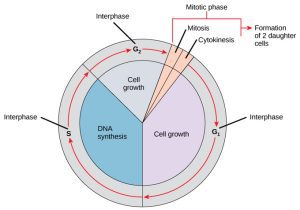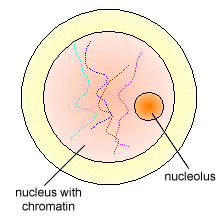
Understanding the Cell Cycle
The cell cycle is a highly regulated sequence of steps that occurs before a cell divides. Cell division is crucial for survival, allowing the body to replace damaged cells, contribute to growth, and facilitate tissue repair. Mitosis, the primary process of cell division in eukaryotes, is a form of asexual reproduction, which means that the parent cell produces two identical daughter cells, both genetically identical to the parent cell. This process may not lead to genetic diversity, but it is an efficient way to ensure old or damaged cells are replaced consistently.

Table of Contents
ToggleThe Importance of the Cell Cycle
In eukaryotic cells, the cell cycle is regulated to ensure orderly growth and reproduction of cells. When this process fails to be properly controlled, cells may begin to divide without restriction, leading to conditions such as cancer. To prevent this, the cell cycle includes checkpoints and regulatory signals that oversee each phase. The frequency of cell division can vary significantly depending on the type of cell; some cells divide frequently, while others rarely or never do.
The cell cycle consists of five main phases: Interphase (which includes G1, S, and G2), Mitosis, and Cytokinesis.
Interphase
Interphase is the period of growth and preparation for division, comprising over 90% of the cell cycle. During this phase, the cell is not actively dividing but is carrying out the processes needed for future cell division. The chromatin within the nucleus remains threadlike, and during the S phase, the centrosome is duplicated.
G1 Phase: The cell undergoes intense growth and metabolic activity.
S Phase: DNA synthesis occurs, leading to the replication of genetic material. This ensures that the cell will have two identical sets of DNA.
G2 Phase: The cell continues to grow and prepare for mitosis by producing the necessary components for division.

The cell may also enter a G0 Phase, where it ceases to divide. Cells in the G0 phase can sometimes re-enter the cell cycle upon receiving specific signals, while dividing cells can exit the cell cycle as well. Cell division is regulated by growth factors through a signal-response pathway, ensuring that cells divide only when it is appropriate.
Mitosis
Mitosis is the process by which the nucleus of the cell is divided. Even though mitosis is considered one continuous process, it is typically divided into four distinct stages: Prophase, Metaphase, Anaphase, and Telophase.
Prophase: The nuclear membrane begins to break down, and chromatin condenses into distinct chromosomes. The spindle apparatus starts to form, preparing for chromosome separation.
Metaphase: The chromosomes align along the metaphase plate, which is the central plane of the cell. The centrosomes move to opposite poles of the cell.
Anaphase: The centromeres split, separating the sister chromatids, which are then pulled to opposite poles by the spindle fibers.
Telophase: The chromosomes reach the poles and begin to uncoil, returning to their threadlike form. The nuclear membrane reforms around each set of chromosomes, completing mitosis.

Cytokinesis
Cytokinesis is the final step of the cell cycle, involving the division of the cytoplasm to produce two distinct daughter cells. The process of cytokinesis differs slightly between plant and animal cells:
In Plant Cells: A cell plate forms between the two daughter cells, which eventually develops into a rigid cell wall. This structure helps plant cells maintain their shape and supports tissue integrity.
In Animal Cells: A cleavage furrow forms, which is a groove on the cell surface that gradually deepens to separate the two daughter cells. The cleavage furrow is facilitated by actin filaments that contract and divide the cell’s cytoplasm.
The proper regulation of these stages ensures that cells divide at the appropriate times and maintain the health and functionality of tissues.
The Role of Regulation in the Cell Cycle
The cell cycle’s regulation is crucial for preventing disorders like cancer, where unchecked cell growth can occur. Regulatory checkpoints are in place throughout interphase and mitosis to ensure cells only divide when conditions are optimal and resources are available. Checkpoints prevent the replication of damaged DNA, helping maintain genetic stability.
Depending on the cell type, cells may divide frequently, such as in skin or intestinal cells, or enter a state of permanent non-division, as is the case with neurons. Understanding the mechanisms of the cell cycle and its regulation is essential in understanding various biological processes, including growth, tissue repair, and immune response, as well as disease pathology such as cancer.
Final Thoughts
The cell cycle is fundamental to life, enabling growth, development, and repair. It is a remarkable example of biological precision, ensuring that new cells are created and old or damaged cells are replaced efficiently. By maintaining the right balance between cell division and differentiation, organisms can respond to their environments, adapt, and thrive.
Further Reading & Study
Explore more about the cell cycle and mitosis in AP Bio Unit 4 Replays or watch the 2021 Unit 4 Cram for detailed insights.
Delve deeper into the regulation mechanisms of the cell cycle and learn how dysfunctions in this process can lead to diseases such as cancer.
Recent Posts
- 2.4 Identifying techniques in poetry to analyze literary works
- 2.3 Analyzing word choice to find meaning
- 2.2 Understanding & interpreting meaning in poetic structure
- 2.1 Identifying characters in poetry
- Unit 2 Overview: Introduction to Poetry
- 1.6 The basics of literary analysis
- 1.5 Reading texts literally and figuratively
- 1.4 Understanding and interpreting a narrator’s perspective
- 1.3 Understanding how a story’s structure affects interpretations
- 1.2 Identifying and interpreting setting
- 1.1 Interpreting the role of character in fiction
- Unit 1 Overview: Introduction to Short Fiction
- Laws of Indices – Number & Algebra – IB Mathematics AA HL
- Standard Form – Number & Algebra – IB Mathematics AA HL
- 9.2 Crafting an argument through stylistic choices like word choice and description
Choose Topic
- ACT (17)
- AP (20)
- AP Art and Design (5)
- AP Physics 1 (1)
- AQA (5)
- Artificial intelligence (AI) (2)
- Banking and Finance (6)
- Biology (13)
- Business Ideas (68)
- Calculator (72)
- ChatGPT (1)
- Chemistry (3)
- Colleges Rankings (48)
- Computer Science (4)
- Conversion Tools (136)
- Cosmetic Procedures (50)
- Cryptocurrency (49)
- Digital SAT (3)
- Edexcel (4)
- English (1)
- Environmental Science (2)
- Exam Updates (1)
- Finance (17)
- Fitness & Wellness (164)
- Free Learning Resources (209)
- GCSE (1)
- General Guides (40)
- Health (107)
- History and Social Sciences (152)
- IB (1)
- IGCSE (2)
- Image Converters (3)
- IMF (10)
- Math (39)
- Mental Health (58)
- News (8)
- OCR (3)
- Past Papers (463)
- Physics (5)
- SAT (39)
- Schools (3)
- Sciences (1)
- Short Notes (5)
- Study Guides (28)
- Syllabus (19)
- Tools (1)
- Tutoring (1)

